Fuerteventura is one of the Canary Islands, a part of Spain, that lies 60 miles off the coast of Morocco. Like the other Canaries, it’s a volcanic island, with extinct volcanoes and cinder cones dotting the landscape in every direction. Like the nearby Sahara desert, the sun shines almost every day of the year here.
Fuerteventura boasts some of the best beaches in all Europe. Long stretches of fine white sand embrace the coastline. Crystal clear aqua water laps it’s shores. The dry, mild climate makes Fuerteventura an ideal destination anytime of the year. Constant winds, and the surrounding sea act to moderate temperatures. Water temperatures vary from about 65-80 F. depending upon season.
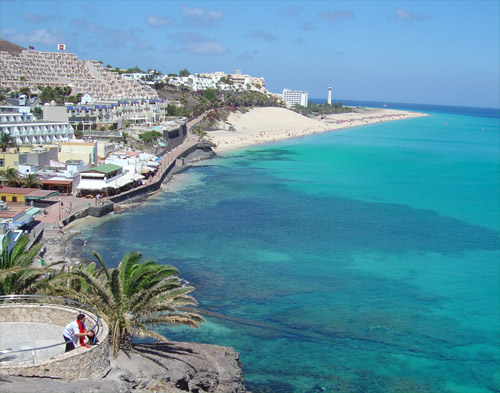
Jandia Beach, Morro Jable
What to See & Do on Fuerteventura
Beaches
Everyone visiting Fuerteventura come for its world famous beaches. You won’t be disappointed as they are fabulous. Clean, fine white sand stretching for miles, along with clear, turquoise seas that will tempt you to linger all day at the beach. But beware of the sun! The constant breezes that keep you cool, even on the hottest days, will lull you into thinking you’re not getting a sunburn. Wrong! Unless you’ve already got a good tan, you must use sunscreen with at least a 15 rating, especially at first. Make sure you get every inch of exposed flesh evenly covered. If you’re going nude don’t forget your butt and privates too. A beach umbrella is a wise investment if you plan to spend most of the day on the beach.
Nudism:Ah yes, nude sunbathing is very popular on Fuerteventura. You might even say legendary. Fuerteventura is a naturist paradise. You can go nude just about anywhere on the island, but it’s good to avoid the most crowded spots, usually in front of hotels with lots of children and parents (unless they’re nude too!). Just walk down the beach a hundred meters or so away from the crowds, and it’s cool. Women can go topless anywhere. This includes poolside at your hotel. It’s completely normal for the sophisticated European crowd that visits Fuerteventura.
You’ll notice rock circles about three to five feet high on many of the beaches. These are wind shelters where you can escape the ever present breeze, and get a little more privacy too. Some of these have been “improved” by visitors with driftwood benches and ledges, giving them an almost homey feel.
Shopping
Fuerteventura is a great duty-free place to shop. Whether you’re looking for beach items, resort wear, electronics, or booze, you’ll find great selection and values. Cheap beachwear from t-shirts to sandals to towels are available everywhere. The quality of those items might not be the best, but who’s going to quibble over a 3 euro t-shirt?
Electronic items from top of the line digital cameras to tiny mp3 players, can be found at very reasonable prices. The only catch is you’ll probably have to bargain a bit to get a good deal. It’s all part of the game, and it’s all very friendly. The island’s electronic stores are owned by Indian merchants who will first test you to see if you know the prices. Since no prices are on display, you might want to try a few stores and see how low they’ll go before you make your purchase. They all seem to have pretty much the same items, more or less. Be firm on what you want otherwise they will try to steer you to an inferior, no name item with a big markup.
Like Spain, wine and spirits are excellent value. A good bottle of Spanish wine runs around 4 euros, while a whole liter of excellent 10 year old Spanish brandy can be had for around 13 euros. Even the duty free shops in the airport offer similar bargains to the supermarkets. However you are still limited by customs restrictions when returning to the EU or other countries. (EU limit is one liter of spirits and two bottles of wine). But there’s nothing to stop you from chugging down all you can while you’re on the island.
Jewelry & perfume shops abound too, but you should know what you’re buying first. Most resort towns on Fuerteventura feature a market once or twice a week. Here you can find some bargains, but again you must haggle a bit. African art, mostly wood carvings are featured at these markets. The African vendors seem somewhat aggressive, but they’re actually pretty mellow and friendly.
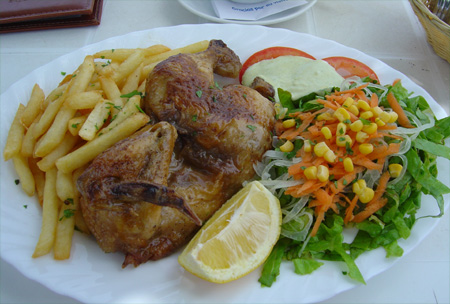
Typical Spanish Roasted Chicken (about 5 Euros)
Food
The surrounding Atlantic waters provide a bounty of fresh seafood that can’t be beat. The local catch includes langoustinos (small lobsters), clams, tasty tuna, swordfish, delicious John Dory, excellent jumbo prawns, sea bass, parrot fish and more! If you like catching your own, you’ve come to the right place. Fishing boats ply the waters between Fuerteventura and the coast of Africa with tuna and swordfish being the big prizes, easily found.
An abundance of good restaurants can be found in towns and villages around the island. Almost all Fuerteventura restaurants specialize in seafood, with Spanish, Italian and Chinese cuisines predominating. You can also find English, German, French, Thai, even Mexican popular with tourists.
Many of the island’s hotels offer half board or all-inclusive packages that limit your outside dining opportunities. Apartment type accommodations are also very popular, for self-catering types. There are always supermarkets a short walk away, offering a wide variety of food and produce catering to European tastes, with Spanish brands dominant.
The range of produce, bakery items and packaged products available is pretty much what you’d find in Spain, with a few more tropical items like papayas added. Fortunately you’ll also find supermarkets stocked with English, German & Dutch items for variety.
One of the great things about Fuerteventura is the excellent value found in restaurants and supermarkets. A typical English breakfast (eggs, toast, beans, sausage) runs around 3 euros in a restaurant. Seafood lunches with salad and veggie side can be as cheap as 5 euros, occasionally including a drink like sangria. A good dinner with drinks might set you back 10-20 euros per person. Compare these prices with seaside resorts on the continent, what a deal! And the food is often better, too!
A specialty of Canary Islands is the salted potatoes served with mojo sauce. These delectable treats are new potatoes boiled in salty sea water, covered in a spicy pepper sauce similar to some Caribbean hot sauces (but not quite so hot). Check out this recipe: https://www.globalgourmet.com/food/special/2000/vegetarian/mojo.html
Places to Visit
Corralejo
(30 minutes north of airport) – At the north tip of the island is the picturesque town of Corralejo. A rather laid-back port town it’s noted for the ferry connections to nearby Lanzarote and Lobos islands. It’s also a great place to shop, people watch and dine. There’s a mile long stretch of shops on one street ending at the old port town with narrow alleys, restaurants and bars everyway you turn. In the evening there is live music scattered around at various restaurants & bars & clubs.
The Café Latino has a nice view of the bay, cheap eats, friendly service and DSL Internet access for the best price I found (3 Euros per hour). Along the bay are a string of restaurants and a couple of fine white sand beaches, very safe for children. You can also rent windsurfing gear right next to the Waikiki Restaurant, which serves up a very good fish lunch including a glass of Sangria for 5.20 Euros.
There are a number of supermarkets in Corralejo, so it’s a good place to get beach supplies & groceries. There’s an open market twice a week, on Monday and Thursday, which has mostly tourist stuff – T-shirts, shorts, towels, African art, and not a whole lot more, but it’s a nice hour’s browse.
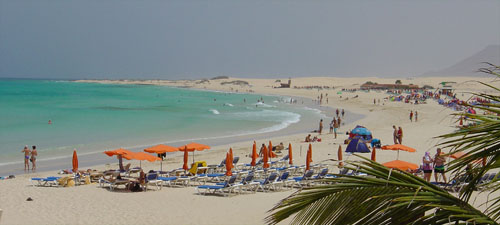
Corralejo Beaches
But the real reason for visiting or staying in Corralejo are the long streches of beach perfection just outside of town. Huge dunes of fine sand blown over from the Sahara Desert form what is now a nature reserve that includes a number of superb, uncrowded beaches. Like a magnet, these white sands draw sunworshippers from all over Europe including windsurfers, kite-sailors, and especially nudists.
The water here is excellent. It’s clean, clear and a beautiful turquoise color. There are rock outcrops along the shore which are good for tidepool exploration and snorkeling. There are lots of colorful fish, and even along the water’s edge you’ll encounter schools of small silver fish swimming around your feet.
All along the beaches you’ll find meter high rock circles, which make good shelters from the constant trade wind coming from the north. Here people camp for the day, using the shelters for a bit of privacy as well as wind break.
Public access to these beaches is thru the dunes. Be very careful on the stretch of road along the beach leading to Corralejo. The sandy shoulders will trap most vehicles quite easily. Only pull off where you see others have without burying their wheels in sand.
You can also park in the lot of the only Hotel along the beach, the RIU Palace Tres Islas, where access to the beach is much closer. It saves you a long trudge thru the slippery dunes and getting your car stuck. There is no sign for the hotel, but you can’t miss it, as it’s a huge building on the beach. There’s actually two RIU hotels at this location, but one is closed at the moment.
Although most of the beach is very safe for bathing, do watch the flags on the beach for bathing conditions. Don’t swim where there are red flags! Conditions can change during the day. Also no matter what your skin color, use high SPF sunscreen!
Jandia and Morro Jable(about 90 minute drive from airport)
At the southern tip of Fuerteventura lies another resort named alternately Jandia and Morro Jable. Jandia is the larger region that comprises the long peninsula in the south of the island, whereas Morro Jable is the municipality including the old town. The beautiful beach that extends down the peninsula for miles is called Jandia Beach.
Today the area around Morro Jable is a very developed part of the island. There’s even a new mall opening soon. This area has been popular with German tourists for a few decades, predating the other tourist areas. I noticed a lot of young people here, unlike other sections of the island where the majority of tourists are older folks.
This area is full of restaurants, hotels and self-catering apartments. The beach is a long wide stretch of white sand that goes for many kilometers north. At the south end of town there’s a cliff you can walk up with outstanding views of the beach & surrounding town.
Morro Jable is a bit more upscale than Corralejo, and it’s developed more like the mainland Spanish coast with wall-to-wall hotels, but lowrise only. Also I noticed there was no nudity in the more crowded section of beach as you get closer to the old town. More families with children here.
Caleta de Fustes (10 minutes from the airport)
This recent development includes a large waterfront complex with self-catering apartments, lots of shops, restaurants, bars and a small marina. You’ll also find here the Atlantico Shopping Centre which includes an eight screen cinema, a hypermarket, even a bowling alley. This area is more popular with English tourists. You can find DSL Internet access here at Ciao Ciao Italia Café seven days a week.
Across the main highway is the residential development of Caleta de Fustes. Most of the resorts, apartments and villas are a fair distance from Caleta’s waterfront, so a car is very helpful if you stay here. Some of the best deals on self-catering apartments or villas can be found in this area. However the distance from good beaches is the main drawback.
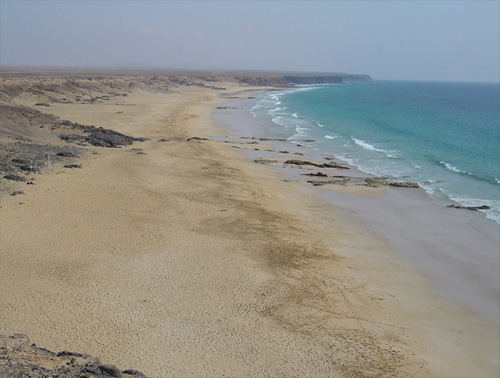
Playa del Castillo – Great Surfing!
El Cotillo
This tiny fishing village on the northwest coast of Fuerteventura boasts a couple of outstanding beaches. The first is a circular bay just north of town, where the water is very calm and the sand is as fine as any on the island. This beach is perfect for young children and snorkeling. There’s an outdoor café right on the beach serving up good grub, so you needn’t worry about going hungry or thirsty in this remote part of the island.
The road north continues to the Faro or lighthouse at the northernmost point of the island. Here fishermen ply the waters and people camp on the beaches to the east (many in caravans). Sadly, that is the only place I saw beach camping still allowed on Fuerteventura.
If you can find your way to the south of town you’ll see the sheltered marina and just beyond a huge beach, Playa del Castillo, that attracts surfers and hippie types. Here you’re facing the Atlantic Ocean so the ocean swells can get rough. Just what the Kahuna ordered!
El Cotillo is the only town on the west coast of Fuerteventura so it’s worth a visit to see what that rugged coastline is like. Quite a contrast to the calm waters on the east side. You’ll need a four-wheel drive vehicle to explore further down the coast to the more secluded bays and beaches.
El Cotillo is being developed as a resort with more apartments and villas available for rent. Good seafood restaurants serve up the fresh catch from the village fishermen.
Puerto de Rosario
The administrative capital of Fuerteventura is a laid-back town of around 20,000 people very close to the airport. There’s little reason to venture here, unless you have some official business to attend to. There’s a nice promenade along the seafront, but little for the tourist to appreciate.
Fuerteventura’s Wild West Coast
For those who really want to get away and explore the rest of the island, we recommend you rent a four-wheel drive or motorbike and flee the tourist centers for at least a day. All along the west coast of the island are dirt roads that lead down to isolated beaches. One of those beaches has what remains of a huge shipwreck. (Do not attempt to visit the wreck! It’s extremely dangerous!)
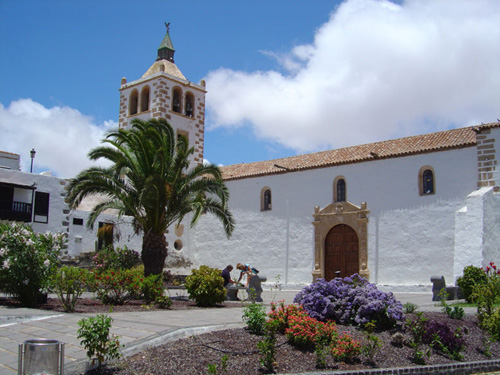
Church at Bentancuria
The Interior
Fuerteventura’s arid interior resembles a moonscape at times. Volcanic cinder cones and rocks are strewn about with little vegetation to obscure the views. However there are a few small towns that make a day’s exploration rewarding.
Betancuria is one of the oldest settlements on the island. Rising above the town is a beautiful church done in the Canary Island style. The town has been restored and is now a popular tourist stop with an award-winning restaurant near the church. A museum houses archeological artifacts of the original inhabitants of the area.
This area has the most fertile soil, which washes down to fields during the rare rains that grace the island. (The island is currently in the middle of a prolonged drought of many years).
Antigua, one of the oldest villages on Fuerteventura, is home to the Cruz de los Caldos, a beautiful 500 year old church. Further down the road is the Molino del Antigua, a restored windmill and craft center is surrounded by a well maintained cactus garden.
La Oliva is another small town, surrounded by large cinder cones. It hosts an interesting and picturesque church and the Museum of Grains. There’s also an unusual restaurant here.
Pajara is not much, but there’s a nice little park along the dry streambed, ablaze with flowers. You could stop here for some eats or a picnic lunch. If you are heading south from Pajara there are some outstanding views down canyons to the sea. There are several viewpoints along the mostly single lane road. Drive carefully along this stretch.
Nightlife
Most options for evening entertainment is focused in the resort towns. Bars and clubs often have local live music to draw people in. English style pubs seem to be the most popular. Some larger hotels feature their own bars or discos with live entertainment. During my stay, my hotel offered one or two shows a nite, including a Rio Carnival night, and a Vegas style famous impersonator nite (with 4 different impersonators). Other than that, there’s not a lot going on during the evenings. Well hey, people don’t come to Fuerteventura for the urban experience, do they? Try Barcelona if that’s what you really want. BTW, don’t expect to find those nice mind-stimulating/relaxing intoxicants here that you might in urban Spain (I’m talking cannabis & other club drugs). There maybe some around, but unless you endear yourself to the locals, they’re not likely to offer you any.
Side Trips
If you have enough time, it’s well worth it to visit another of the Canary Islands. If you enjoy the start volcanic landscapes, you’ll find more on Lanzarote, a short ferry ride away. With an active volcano and all sorts of interesting formations, Lanzarote is a vulcanologists’ dream. With a population of 40,000, the main town of Arrecife is much larger than any town on Fuerteventura.
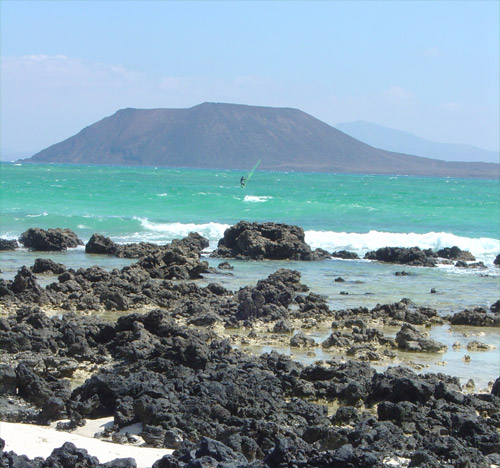
Lobos Island
Los Lobos is a small island very close to Corralejo. It’s virtually uninhabited except for daytrippers. Empty sandy beaches and undisturbed interior draw people with that castaway fantasy. It’s only a 15 minute ride from Corralejo via a Glass Bottom boat.
Gran Canaria and the other Canary Islands
You can visit Gran Canaria, Tenerife, La Palma & the other Canaries by taking a plane or ferry from Puerto Rosario, or a fast hydrofoil from Morro Jable. These islands offer a more lush experience as they are verdant with higher peaks to capture rainfall. The other big islands are also more developed and crowded, but well worth a visit. You will not be able to visit these islands and return in one day unless you fly. We recommend a more leisurely pace to explore these other islands, or save them for your next trip.
Getting to Fuerteventura
There’s no doubt the Canary Islands are remote. So getting there can be a problem if you’re not already in a major European city. Most of the flights coming to Fuerteventura are charter flights from Germany, Holland, mainland Spain, the UK and Italy. Iberia offers regular flights from Madrid.
If you’re coming from the US or other non-European countries I would recommend booking a charter/package deal from the UK or Holland. You can also get last minute deals on charter flights alone without hotel included.
Transavia flies from Amsterdam 31 20 406 0406 (the Netherlands) or 34 90 201 0105 (Spain)
You can also try https://lastminute.nl for the cheapest flight only or package deal. The website is in Dutch, but you can probably figure it out. You can also call their operators (they speak English). I paid only 99 Euros round trip from Amsterdam with them, but such a deal is rare!
From Spain, Iberia & Spanair fly into Fuerteventura.
Where to Stay on Fuerteventura
Like most of the Canary Islands, Fuerteventura specializes in charter tours. That means that airfare & lodging and often some meals are included in a package. This is great for couples as you can get some excellent deals, especially in the off-season. In addition there are many self-catering apartments and villas for rent which are ideal for families or groups.
The independent traveler will have to hunt a bit more to escape the packages and family resorts, but there are plenty of options. We list a few hotels & villas in Corralejo, Fuerteventura that you can book separately. See the Getting There section for more info on flights.

